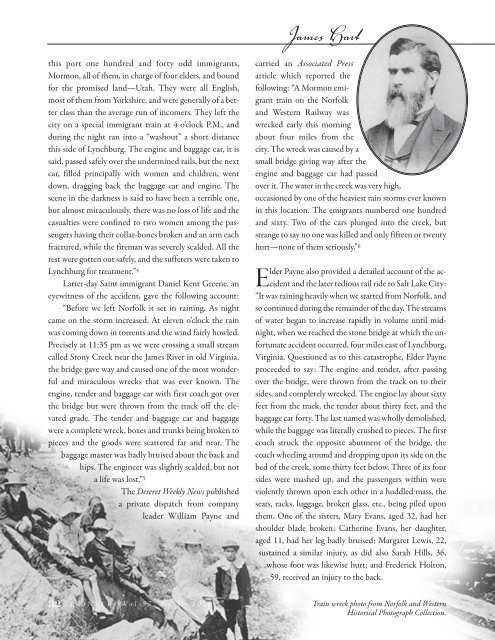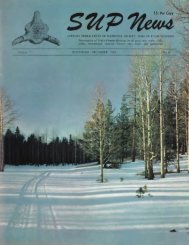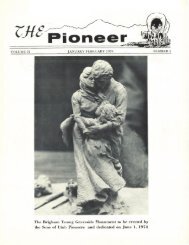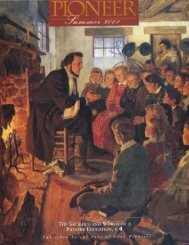You also want an ePaper? Increase the reach of your titles
YUMPU automatically turns print PDFs into web optimized ePapers that Google loves.
James Hart<br />
this port one hundred and forty odd immigrants,<br />
Mormon, all of them, in charge of four elders, and bound<br />
for the promised land—Utah. They were all English,<br />
most of them from Yorkshire, and were generally of a better<br />
class than the average run of incomers. They left the<br />
city on a special immigrant train at 4 o’clock P.M., and<br />
during the night ran into a “washout” a short distance<br />
this side of Lynchburg. The engine and baggage car, it is<br />
said, passed safely over the undermined rails, but the next<br />
car, filled principally with women and children, went<br />
down, dragging back the baggage car and engine. The<br />
scene in the darkness is said to have been a terrible one,<br />
but almost miraculously, there was no loss of life and the<br />
casualties were confined to two women among the passengers<br />
having their collar-bones broken and an arm each<br />
fractured, while the fireman was severely scalded. All the<br />
rest were gotten out safely, and the sufferers were taken to<br />
Lynchburg for treatment.” 4<br />
Latter-day Saint immigrant Daniel Kent Greene, an<br />
eyewitness of the accident, gave the following account:<br />
“Before we left Norfolk it set in raining. As night<br />
came on the storm increased. At eleven o’clock the rain<br />
was coming down in torrents and the wind fairly howled.<br />
Precisely at 11:35 pm as we were crossing a small stream<br />
called Stony Creek near the James River in old Virginia,<br />
the bridge gave way and caused one of the most wonderful<br />
and miraculous wrecks that was ever known. The<br />
engine, tender and baggage car with first coach got over<br />
the bridge but were thrown from the track off the elevated<br />
grade. The tender and baggage car and baggage<br />
were a complete wreck, boxes and trunks being broken to<br />
pieces and the goods were scattered far and near. The<br />
baggage master was badly bruised about the back and<br />
hips. The engineer was slightly scalded, but not<br />
a life was lost.” 5<br />
The Deseret Weekly News published<br />
a private dispatch from company<br />
leader William Payne and<br />
carried an Associated Press<br />
article which reported the<br />
following: “A Mormon emigrant<br />
train on the Norfolk<br />
and Western Railway was<br />
wrecked early this morning<br />
about four miles from the<br />
city. The wreck was caused by a<br />
small bridge giving way after the<br />
engine and baggage car had passed<br />
over it. The water in the creek was very high,<br />
occasioned by one of the heaviest rain storms ever known<br />
in this location. The emigrants numbered one hundred<br />
and sixty. Two of the cars plunged into the creek, but<br />
strange to say no one was killed and only fifteen or twenty<br />
hurt—none of them seriously.” 6<br />
Elder Payne also provided a detailed account of the accident<br />
and the later tedious rail ride to Salt Lake City:<br />
“It was raining heavily when we started from Norfolk, and<br />
so continued during the remainder of the day. The streams<br />
of water began to increase rapidly in volume until midnight,<br />
when we reached the stone bridge at which the unfortunate<br />
accident occurred, four miles east of Lynchburg,<br />
Virginia. Questioned as to this catastrophe, Elder Payne<br />
proceeded to say: The engine and tender, after passing<br />
over the bridge, were thrown from the track on to their<br />
sides, and completely wrecked. The engine lay about sixty<br />
feet from the track, the tender about thirty feet, and the<br />
baggage car forty. The last named was wholly demolished,<br />
while the baggage was literally crushed to pieces. The first<br />
coach struck the opposite abutment of the bridge, the<br />
coach wheeling around and dropping upon its side on the<br />
bed of the creek, some thirty feet below. Three of its four<br />
sides were mashed up, and the passengers within were<br />
violently thrown upon each other in a huddled mass, the<br />
seats, racks, luggage, broken glass, etc., being piled upon<br />
them. One of the sisters, Mary Evans, aged 32, had her<br />
shoulder blade broken; Catherine Evans, her daughter,<br />
aged 11, had her leg badly bruised; Margaret Lewis, 22,<br />
sustained a similar injury, as did also Sarah Hills, 36,<br />
whose foot was likewise hurt; and Frederick Holton,<br />
59, received an injury to the back.<br />
PIONEER ◆ Vol. 57, <strong>No.2</strong> ◆ <strong>2010</strong><br />
32 Train wreck photo from Norfolk and Western<br />
Historical Photograph Collection.







